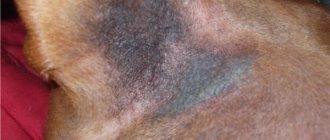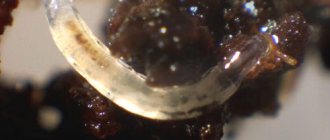Imagine the situation: the owner comes home from work. He goes into the “thoughtful corner” to tidy up the cat’s litter box. And there they find black, very black feces. The owner is in shock, grabs the cat and rushes to the veterinary clinic. At this point it’s time to say: “Stop”! In what situations is specialist help needed if a cat has black feces? Should you take your pet to a veterinary hospital?
Fecal norms
Yes, there are certain standards for cat poop that require the poop to be light brown to dark brown. The final color depends on the animal's diet. In terms of consistency, normal bowel movements are like a long sausage. Everything else is a deviation from the norm, especially when it comes to black feces in cats. This color of stool indicates internal bleeding. However, before you panic, let's understand the causes of black poop.
Life and management
The duration and type of treatment for your cat will depend on the underlying cause of the melena. Initially, daily blood testing may be required to assess your cat's ongoing anemia, which may evolve into weekly testing once your cat's health has stabilized. In cases with regular episodes of vomiting, it is necessary to maintain hydration to correct fluid deficiency. Monitor your cat for blood or color changes in its stool during treatment, and tell your veterinarian if anything seems unusual, including changes in behavior.
Most patients recover after treatment of the underlying disease. Because melena is just a symptom, the overall prognosis will depend on the diagnosis and treatment of the underlying disease or condition.
Nutrition
Let's start with the last reason. A question that Murok and Barsikov owners often ask is whether cats can have raw meat? They can do anything, but their usefulness is in question. Cats and cats are allowed to eat raw meat in small quantities. Just before you treat your pet to something tasty, you need to defrost and scald the product with boiling water.
The reasons for black feces in cats lie in overeating meat. When the pet has enjoyed a hearty meal the day before, the owner will receive a surprise in the morning. In this case, panic is not appropriate, because there is nothing terrible. A completely normal reaction of the body to “overeating” raw meat.
By the way, if the animal takes any nutritional supplements containing iron, then black feces are completely normal. The same can be said for foods high in iron.
Diagnostic methods
A thorough examination is required to make a diagnosis and prescribe therapy. First of all, the doctor must find out from the cat’s owners when and under what circumstances the changes began. The diet, previous diseases and features of the clinical picture are refined. After a general examination and temperature measurement, the following diagnostic methods are used in veterinary medicine:
- Analyzes. The cat's blood, urine and feces are taken for examination. The test results allow us to determine the general condition of the furry, the presence of parasites, liver and gallbladder diseases, and poisoning.
- Coagulogram. A study to determine the rate of blood clotting.
- Gastroscopy. Makes it possible to see the true condition of the inner walls of the stomach, detect ulcers or erosion, foreign bodies.
- Ultrasound of the peritoneum. Allows you to determine the presence of neoplasms and cysts, stones or sand in the gallbladder, and intestinal obstruction.
- Radiography. Detects liver enlargement and the presence of tumors.
- Biopsy. If a tumor is detected, the affected tissue is collected for analysis. Against the background of black feces and the accompanying clinic, the liver often suffers.
General examination Clinical examination Ultrasound of the peritoneum
Diseases of the gastrointestinal tract
The most dangerous causes of black excrement. Diseases are divided into several types:
- Gastritis or colitis caused by injury to the stomach or small intestine. Chicken bones consumed by a cat are the most common cause of such injuries.
- Peptic ulcer of the stomach, duodenum, enterocolitis are diseases that provoke the appearance of black feces in cats. Bleeding ulcers that appear on the walls of these organs cause this phenomenon.
- Hemorrhagic gastroenteritis - exfoliation of the epithelium of the mucous membrane of the stomach and intestinal sections. Injury to small vessels and bleeding occurs.
Prevention
To ensure that your cat does not have problems with defecation, and that the color and consistency of feces always corresponds to the norm, it is important to follow simple preventive rules. Once every six months, the animal should be treated with anthelmintic drugs and treated for cat lice and fleas. In addition, it is worth adjusting the diet and, if necessary, switching to ready-made medicinal factory feed. If your pet's stool stinks and has an uncharacteristic color, it is forbidden to self-medicate. Only a treatment regimen correctly selected by a doctor will help eliminate the disease and prevent complications.
Symptoms requiring veterinary attention
What to do when your cat's stool is black and hard like peas? It is quite possible to have constipation associated with intestinal adhesions. It is necessary to go to the veterinarian as soon as possible.
Symptoms that require visiting a specialist:
- Increased body temperature in an animal.
- Loose stool in a cat.
- Frequent, profuse vomiting mixed with blood.
- Refusal of food and treats.
- The cat won't let you touch his underbelly.
- Moving away from people, the pet tries to hide, and a slight trembling occurs.
- Bloody spots in excrement.
- Weakness and lethargic behavior.
The listed symptoms and black color of excrement require prompt veterinary intervention. Self-treatment at home, without an established diagnosis, will lead to the death of the animal.
Diagnostic methods
To understand the reason for the change in the properties of excrement in an animal, it can undergo gastroscopy.
Before you begin to treat a disease, it is necessary to find out its causes and establish an accurate diagnosis. Therefore, you cannot do without a visit to the doctor. During the initial examination, the doctor will ask the owner how long the animal has been suffering from this condition, what other symptoms are present, and collect other important information. To confirm the diagnosis, a referral is given for the following additional diagnostic procedures:
- urine and blood analysis;
- biochemistry;
- microscopic examination of feces;
- radiography;
- Ultrasound of internal organs;
- gastroscopy.
Treatment
Attention! The following information is published so that the pet owner can calculate the approximate costs of treatment. It is strictly forbidden to use the listed medications without the recommendation of a veterinary specialist!
First of all, veterinarians prescribe medications that stop bleeding. Most are injected intravenously or intramuscularly. Full treatment begins after the bleeding has completely stopped. Otherwise, there is a high risk of losing the animal.
Drugs used to stop bleeding:
- "Tranexam." Use every 6-8 hours until bleeding stops completely. Your veterinarian will advise you on the recommended proportions. The medicine is administered both intramuscularly and intravenously, depending on the general condition of the animal. The price of the solution starts from 800 rubles for 5 ampoules.
- "Vikasol 1%". It is administered intramuscularly for 3-5 days. The price of the drug is from 60 rubles, depending on the volume of ampoules. There are 10 ampoules in a package.
- "Dicynon" is used for 3 days, administered intramuscularly. The price starts from 600 rubles for 10 ampoules.
- Aminocaproic acid 5%. It is used intravenously, the duration of treatment is determined by the veterinarian.
After the bleeding has stopped, they proceed to the use of drugs prescribed by a specialist. In some cases, when bleeding is caused by the presence of a foreign object in the stomach or intestines, as well as a tumor, surgery is performed. Of course, the operation is performed only on the recommendation of a veterinarian. In other cases, the following drugs are prescribed:
- “Prazitel”, “Drontal”, “Pratel”, “Dirofen” - are used against parasites.
- “Tetracycline”, “Gentamicin”, “Amoxiclav”, “Penicillin” are long-acting antibiotics.
- “Gamavit”, “Cycloferon” are antiviral drugs.
- "Almagel", "Ranitidine", "De-Nol" help in the treatment of the gastrointestinal tract.
What to feed a cat during diarrhea
Note that in the first day after the onset of diarrhea, the pet should be put on a starvation diet, without restricting water. Such a “fast” is needed so that during the rest period the animal’s digestive system returns to normal.
But still, what should you feed your pet so as not to burden its gastrointestinal tract, but at the same time not starve it? Even among experienced veterinarians and breeders there are many opinions on this matter, but the “average optimal value” can be deduced from their recommendations:
Boiled rice. It is best to use round varieties, boiling the product to a semi-liquid pulp. This consistency has a positive effect on the condition of the long-suffering intestinal mucosa without further irritating it. The pet should be fed this for the first day or two.
Chicken bouillon. The better the cat becomes, the more saturated broths can be used. We warn you once again that at first it is extremely undesirable to use fatty foods, as they will almost certainly cause a violent relapse of diarrhea.
Boiled chicken. It is advisable to use the breast as the least fatty part. It is necessary to constantly monitor the cat’s well-being and, if signs of stool liquefaction appear, reduce the amount of meat in its food.
High-quality low-fat by-products
But this must be done as carefully as possible, starting from the first week after the last attack of diarrhea.
Finally, to relieve bouts of diarrhea, you can use pumpkin puree from baby food. The dose is approximately half a teaspoon at a time. The duration of submission is approximately three days.
Price issue
Let's talk about the cost of the listed drugs. The same Prazitel is sold in veterinary pharmacies or hospitals. The price starts from 80 rubles per tablet or from 170 rubles per suspension.
“Drontal” in tablets will cost the animal owner 320-400 rubles, depending on the region of residence.
"Pratel" is a rather expensive drug. For ten tablets you will have to pay from 450 to 600 rubles.
"Dirofen" costs about 120-150 rubles.
The rest of the drugs are sold in regular, human pharmacies. Price categories are quite different, depending on the region where the pharmacy is located.
Bristol scale
English doctors at the Royal Hospital in Bristol have developed a simple but unique scale that characterizes all the main types of feces. Its creation was the result of the fact that experts were faced with the problem that people are reluctant to open up about this topic; embarrassment prevents them from talking in detail about their stool.
Based on the developed drawings, it became very easy to independently characterize your own bowel movements without any embarrassment or awkwardness. Currently, the Bristol Stool Shape Scale is used throughout the world to assess the functioning of the digestive system. For many, printing a table (types of feces) on the wall in your own toilet is nothing more than a way to monitor your health.
1st type. Sheep feces
It is called so because it is shaped like hard balls and resembles sheep feces. If for animals this is a normal result of intestinal function, then for humans such stool is an alarm signal. Sheep pellets are a sign of constipation and dysbacteriosis. Hard feces can cause hemorrhoids, damage to the anus, and even lead to intoxication of the body.
2nd type. Thick sausage
3rd type. Sausage with cracks
Very often people consider such stools to be normal, because they pass easily. But make no mistake. Hard sausage is also a sign of constipation. When defecating, you have to strain, which means there is a possibility of anal fissures. In this case, irritable bowel syndrome may be present.
4th type. Ideal chair
5th type. Soft balls
This type is even better than the previous one. A few soft pieces form and come out gently. Usually occurs with a large meal. Stool several times a day.
6th type. Unshaped chair
The feces come out in pieces, but unformed, with torn edges. It comes out easily without hurting the anus. This is not diarrhea yet, but it is already a condition close to it. The causes of this type of stool can be laxative medications, increased blood pressure, excessive consumption of spices, and mineral water.
7th type. Loose stools
When a visit to the vet should not be postponed
Urgent veterinary care is needed for your pet when the following additional symptoms occur:
- stomach ache;
- plaintive meow;
- temperature above 40 °C;
- diarrhea;
- vomit;
- refusal to eat;
- blood clots in excrement.
Be sure to read:
A cat vomits hair: reasons, what to do, medications and folk remedies, prevention
The most dangerous sign is the appearance of melena - feces with a tarry consistency, indicating large-scale bleeding.
Causes of melena
Tarry stools are a very alarming symptom!
The color of stool is affected by bile, the food itself and the time it spends in the intestines. The normal color of stool is brown, in some cases yellow (if you consume a large amount of dairy products).
If blood from the upper gastrointestinal tract enters the stool, it first mixes with bile and sulfuric acid from the gastric juice, which leads to the formation of black stool. Tarry stool is always a reason to call an ambulance!
The presence of streaks of scarlet blood in it does not indicate the location of the bleeding. Only a doctor can reliably determine the focus. Although the cause is usually bleeding, there is the concept of false melena caused by physiological causes. The stool turns black due to foods or medications consumed.
You can distinguish it by its consistency, that is, the stool turns black, but the consistency is normal. Common causes of false melena:
- Some berries stain the stool. These include black currants and blueberries.
- Beetroot can color feces and urine. When consuming large amounts of beets, the stool becomes black and may be thinner due to the laxative effect of the vegetable. The urine turns red and may appear to be tinged with blood. All these symptoms quickly disappear after stopping consumption of beets.
- Activated carbon also causes stool to become colored. The more tablets taken, the darker the stool will be. The consistency should not change.
- Preparations containing iron turn stool black. This is usually stated in the instructions.
The cause of tarry stools may be bleeding that is not gastric or intestinal, but of a different nature, for example, when swallowing a large amount of blood during a nosebleed or pulmonary hemorrhage. Even if some of these products and drugs have been consumed and there are reasons to consider melena to be false, you should not make a diagnosis yourself; it is better to call an ambulance and undergo diagnostics.
An ambulance will necessarily hospitalize a patient with complaints of melena, even if the paramedic and doctor did not see “confirmation” of the patient’s words. Any bleeding can be life-threatening.
A coprogram is...
Chyme, or food gruel, moves through the gastrointestinal tract and fecal masses are formed in the large intestine. At all stages, breakdown occurs, and then absorption of useful substances occurs. The composition of the stool helps determine whether there are any abnormalities in the internal organs. A scatological examination helps to identify a variety of diseases.
A coprogram is a chemical, macroscopic, microscopic examination, after which a detailed description of the feces is given. Coprograms can identify certain diseases. These may be disorders of the stomach, pancreas, intestines; inflammatory processes in the digestive tract, dysbiosis, malabsorption, colitis.











